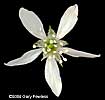
Trees of Wisconsin
| Amelanchier
arborea (F. Michx.) Fernald downy juneberry Family: Rosaceae |
||||||||||||||||
|
||||||||||||||||
|
The leaves of Amelanchier arborea are simple, alternate and regularly toothed. Pubescence on the undersurfaces of the leaves often persists into maturity. The buds are relatively large (up to 10-12 mm) and long tapering to a sharp tip and each bud has more than 2 visible outer scales, often at least partly reddish. The plants may develop a single trunk, but more often they are multiply-stemmed from the base, with stems of well-developed plants reaching 20-30 feet in height or more, therefore appearing as a small tree or a very tall shrub. The flowers are showy with bright white petals opening in May or early June and producing numerous red or purple fleshy fruits. The bark is smooth and gray, reportedly darker in larger individuals, but stems in excess of 15 cm in diameter are rare and in my experience many are less than 10 cm in diameter. Members of this genus are often easy to recognize with a little practice, but the species can be difficult to distinguish in the absence of flowers. In fact they may be difficult even with the flowers and some individuals will appear to be intermediate, making identification very frustrating. Collectors are urged to take abundant samples and to record good field notes. There are also several other, more clearly shrubby species of Amelanchier in Wisconsin, and it is common to find two or more species of Amelanchier in the same area. Hybridization has been widely reported, though it is less often supported convincingly beyond the presence of variable and confusing specimens. The common Amelanchier species all appear to do best in sunny and dry sites, but they may persist as forest grows in around them and they are also found in smaller numbers in a wide variety of habitats, including wetter sites. Amelanchier arborea ranges widely in northeastern North America, from Minnesota and southern Ontario to the maritime provinces of Canada, south through eastern Oklahoma to Louisiana and Georgia. In Wisconsin it is found throughout the state, but the true distribution and commonness is difficult to assess due to reluctance of botanists to collect (and keep) vouchers of these very challenging species. |
|







